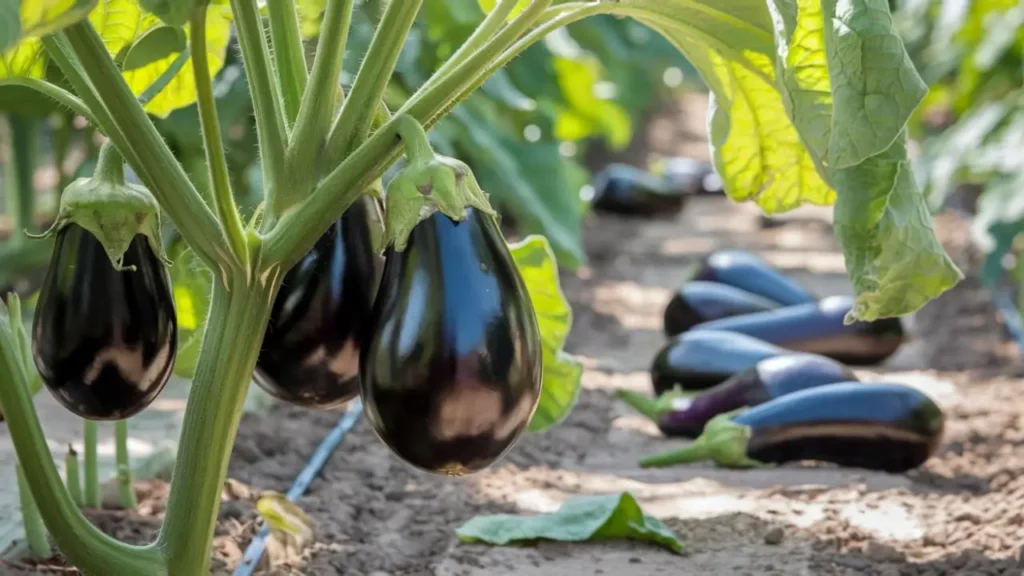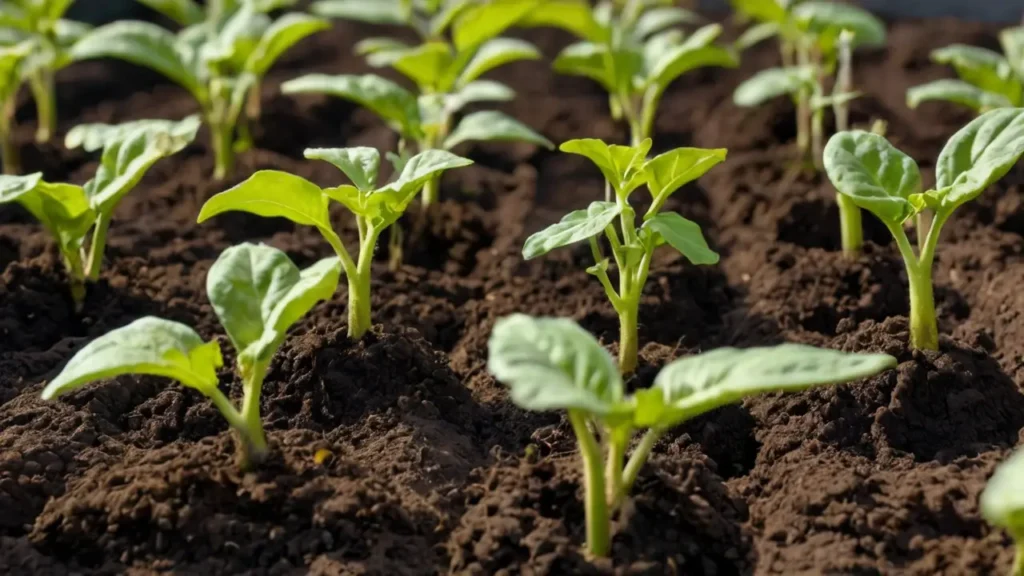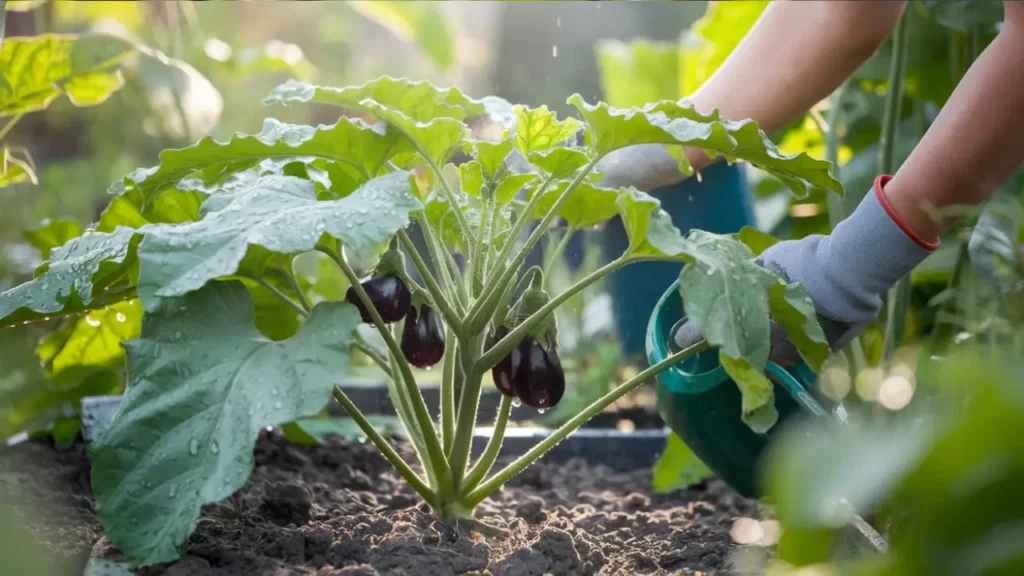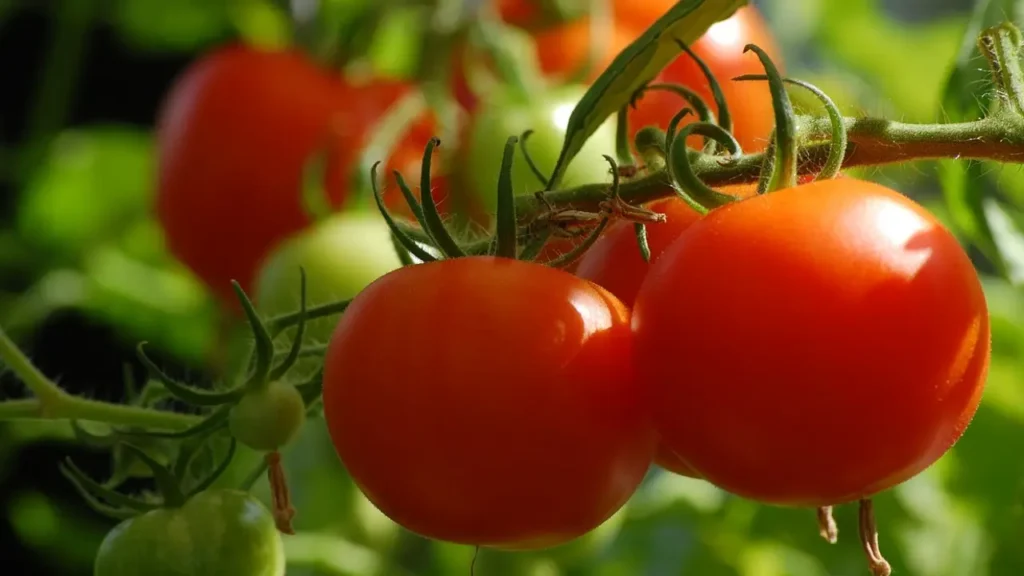Have you ever strolled through a market being fascinated by the color and the shapes of fresh vegetables? Perhaps like many you have savoured the goodness of a well roasted eggplant. Through its fabulous creamy structure and smoky taste that makes the taste buds either do the tango or waltz. It is those opportunities that help gardening to allow those moments to occur in one’s own backyard.
Well you are in luck because how to grow eggplant guide will be your guide through the process of raising your very own eggplants. Whether you are a enthusiast of plants or just a cook who wants to do better. Eggplant can be grown easily and it is rather interesting as a hobby or a pastime. With the right tips, you will be able to savour your summer on a plate all summer long.
Key Takeaways
- Small-fruited varieties like Ichiban can produce abundant fruit during warm summers.
- Eggplants grow best when spaced 24 to 36 inches apart to allow for healthy plant development.
- Successful eggplant cultivation requires soil temperatures between 70° and 85°F.
- Mulching helps maintain consistent soil moisture and reduces weed competition.
- Eggplant varieties come in many colors, each offering distinct flavors and culinary uses.
- Regular watering is essential, ensuring that soil stays moist but not soggy.

Table of Contents
Understanding Eggplant Varieties
They are available in different tastes, colours and shapes, which includes the egg plants. Gardeners simply need to know the differences between types that are out there in the market in order to make a proper choice. It helps in making decisions that enable one to get improved growing and taste outcomes.

Popular Varieties of Eggplant
Some eggplants are famous for their special traits and how they taste:
- Black Beauty: A classic type with deep purple skin and a strong taste.
- Asian Delite: Known for its long shape and mild flavor.
- Orient Express: A Japanese type with shiny, dark purple skin and soft texture.
- Rosa Bianca: An Italian eggplant with pale lavender color and creamy taste.
- Fairy Tale: A small variety with striped skin and sweet taste, great for grilling.
Unique Characteristics of Each Variety
Each eggplant type has its own traits for different cooking needs and growing conditions:
- Asian Varieties: Long and slender, these eggplants are perfect for stir-fries because they have fewer seeds.
- Globe Varieties: These are bigger and stronger, great for cooking and grilling.
- Italian Varieties: Types like Rosa Bianca and Gaudi are great for sauces and roasting because of their rich taste and creamy texture.
- Mini Varieties: Smaller eggplants like Nubia or Gretel are perfect for small dishes or as decorations, with a mild taste that many enjoy.
Such information is very beneficial when choosing the best eggplant varieties to plant in the garden & for many other uses. So if you are fond of small or big eggplants then trust me there is a really good stock available for you.
Choosing the Best Soil for Eggplant
Preparation of the site and selection of the proper type of soil is the main requirement for eggplants growth and fruiting. The ideal soil condition should have good drainage facilities and at the same time should be one which can retain the nutrient. Thus obtaining healthy plants as well as lots of fruit.
Ideal Soil Composition
Eggplants are suited for warm situations with well drained soil and good content of organic matter. The amount and frequency of precipitation, the average temperature, the percentage and type of soil organic material, and the soil pH should be between 5. 5 and 7. 0 for the best growth. Used compost or compost that has aged for several weeks with well-rotted manure increases nutrient content of the soil.
Here’s what the ideal soil mix looks like:
| Component | Ideal Proportion | Benefits |
|---|---|---|
| Sandy Loam | 40% | Improves drainage and facilitates root growth |
| Clay | 20% | Retains moisture and provides nutrients |
| Silt | 30% | Holds nutrients well for sustained plant health |
| Organic Matter (compost/manure) | 10% | Boosts nutrient content and enhances soil structure |
Improving Soil Fertility
The latter should note that organizing a more favourable ground for eggplants starts with placing a layer of manure or compost on the ground before planting. This is beneficial in plant growth as it results to development of strong plant stem. There are plenty of ways to increase the nutrients, and one can apply balanced fertilizers such as 5-10-5.
The nutrient levels should be regulated as the soil is tested frequently to determine when it needs to be added. This helps in maintaining the soil in the right condition that is most suitable for the production of eggplants.
How to Grow Eggplant: Planting Basics
Learning how to grow eggplant starts much earlier than the moment when you plant it in the garden. Timely preparation and planning are what help to achieve maximum results and a great yield. Thus, timing is important in planting and ways of preparing seedlings are also important in ensuring your plants develop and yield well.

When to Plant Eggplant
Eggplant loves warm weather. Sow the seeds of eggplant indoors about 6 to 8 weeks before the final frost of the season. They should be transplanted only when the soil has reached a temperature of at least seventy degrees Fahrenheit. At night temperature should be above 50 Degree F for better growth of the plant.
Eggplants are best planted when the weather is warm, usually late spring or early Summer. It also helps them to develop well.
Preparing Seedlings and Transplanting
You should plant the eggplant seedlings once they have grown to some height of about 3 inches. Space the plants 18cm to 36cm apart each other and 30 to 36cm between each row. Its ventilation is also good which helps with circulation and helps repel diseases.
Transplanting of eggplant requires early staking to cater for the growth of its vines. It provides the plants with what they require especially while they are bearing fruits. To ensure the plants get well rooted and established it is important that the seedlings are watered regularly.
Eggplant Care Instructions
Thus, anyone who has to protect the eggplants must understand what they require. They require precise amount of light and the appropriate place in the farm to thrive. Also, the right watering regime and the use of the organic mulch are also of a great deal.

Sunlight and Location Requirements
Eggplants require much sunlight in order to grow good. It thrives well in areas of full sunlight, in an environment where one is able to get 6-8hrs of sunlit each day. Location of eggplant is critical; warm area will develop soil fast that consequently makes the eggplants develop faster.
It grows most preferably in particular the USDA hardiness zones 9-12. They are fond of warm climate, with the range of 21º to 29ºC.
Watering Needs for Healthy Growth
As is the case with most plants, one must ensure that they use a good eggplant watering guide in order to provide for the plants appropriately. For a citrus tree to develop, mature or even produce fruit, they require around an inch of water each week, with up to 2 inches when its bearing fruit. The moisture level of the soil has to be maintained at optimal level throughout the growing period of the fruits.
Soil should be moist but not wet, it should be moist enough to hold foods in place but not wet for long to spoil them. The best technique that should be used to water them is drip irrigation or soaker hoses since water will not be wasted.
Using Organic Mulch for Moisture Retention
Using of organic mulch for eggplant plays important role for maintaining of moisture in the soil. Leaves or straw can be utilized in maintaining the ground and they serve the role of mulch. Annual weed growth is suppressed by mulch and also they regulate the temperature of the soil which is also commendable for roots.
That is particularly helpful much especially during summer season. It ensures your eggplants receive adequate attention in order to grow properly.
| Key Care Aspects | Details |
|---|---|
| Sunlight Requirement | 6-8 hours of direct sunlight |
| Optimal Soil Temperature | 70ºF minimum for planting |
| Water Requirement | 1 inch per week, up to 2 inches during fruiting |
| Mulch Benefits | Moisture retention and weed suppression |
Fertilizing Eggplants for Optimal Growth
To achieve healthy eggplants the right nutrients are essential. That is the best fertilizer, how to apply it, and when to feed your plants improve the yield of fruits. I will summarize that the selection of the fertilizer very crucial.
Types of Fertilizers to Use
There are two main types of fertilizers: There are two types of materials which can be used in automobile industry; organic and synthetic. Organic ones release nutrients in a slow and steady manner just like how a trust fund releases its money systematically. Natural ones release nutrients slowly and do not harm plants whereas synthetic ones release nutrients quickly and can damage plants if applied in excess. Both types are necessary for plants, as they supply them with nitrogen, phosphorus as well as potassium.
A recommended fertilizer to foster growth is the one with an equal proportion of the nitrogen, phosphorus, and potassium content that is 10:10:10. It also aids in flowering process Besides that, it supports the process of flowering. That is why it is important also to use natural elements such as compost or bone meal to make the soil and plants strong.
Feeding Schedule Recommendations
Eggplant feeding schedule is very important in order to ensure that the plants are healthy. Planters should supplement their plants’ nutrient requirements with fertilizers which should be commenced two weeks after planting. Water your plants for every 4- 6 weeks to ensure the plants grow healthy with little foliage.
It is equally very useful during milestones in lifecycle of organizations. When used in excess, harms either imparts poor quality growth to the plants or turns the leaves brown. It may also cause a burn if this occurs cease fertilizing, water the soil and begin the procedure with a reduced amount of fertilizer.
This way, when testing your soil you come to realize the nutrients needed by the eggplants. This way, you will provide them with the right food for increasing production, thus enabling you to get the best out of them.
Pruning Eggplants for Better Yield
Eggplant pruning as well as proper care help increase growth and produce more of the crop. It aids ventilation and assists the fruit to grow to maturity. An important part to learn on pruning eggplants is that you will be in a better position to take good care of your garden.

Benefits of Pruning
Pruning helps improve your eggplants yield and the fruit ripens to be better in size, flavour and even nutritional value. Research further reveals that pruning each plant to three or four leaders is of great assistance. It also means pruning off shoots with low leaves that are prone to diseases.
When and How to Prune Your Plants
There is nothing as important as knowing when to prune your eggplants and if not, how to do it correctly. Pruning should be done as soon as the plants reaches one foot in height. Trimming off the excess shoot and leaves especially those that hardly grow and those that appear to be weakest should be pruned so that the plant receives adequate light. Second, it is necessary to pinch off the first flowers as it will help the plant to develop a strong root and stem system.
Remove new flowers for a chance of the present fruit to ripen; do this one month before the first frost. This way the production is enhanced and therefore you get a better harvest.
| Pruning Technique | Description |
|---|---|
| Limiting Leaders | Maintain three or four leaders for optimal yield quality. |
| Removing Lower Leaves | Cut off leaves touching the ground or those that are damaged. |
| Early Bud Removal | Remove early flower buds to redirect energy to foliage and roots. |
| Stake Before Height | Stake plants before they exceed 24 inches to prevent breakage. |
| Spacing | Space plants 12 inches apart for best growth and air circulation. |
| Disinfecting Tools | Clean tools with a bleach solution to prevent diseases. |
Pruning is also another aspect that should be approached in a correct manner as it will help your eggplants produce more and become more tasty. It is an important process in how a good gardening should be like. Appreciate the work that you get to do when you get to learn why pruning is essential.
Managing Common Eggplant Pests
A good production of eggplants depends on how these plants are protected from pests which are common in most plantations. Knowing these pests and how to combat them will go a long way in helping gardeners take good care of their eggplants. Early identification is very vital, as well as the ability to determine how these pests can invade in the first instance.
Identifying Eggplant Pests
There are quite a number of pests that are known to cause havoc to your eggplants. Flea beetles are not very large, but they cause small-shaped holes on the leaves of plants and are commonly found on weedy land. They make many eggs and are often seen around some plant such as Horsenettle and pokeweed plant.
The numerous Colorado potato beetles feed on leaves and reproduce in about a week producing over 500 eggs. Green peach aphid hysterically tends to change the shape of the leaves then cause stunted plant growth. If you see silverleaf whitefly on leaves then there is likely to be an issue. Finally, two-spotted spider mites make the leaves of the plant turn pale and dry up by drawing the life out of the plant.
Preventive Measures and Treatments
For pests problems, apply preventive actions. Using row covers can protect young plants from pests once it is placed on the rows. When to spot the pests and diseases such as bacterial wilt and Phytophthora blight, monitor your plants often and ensure that you intercrop with non-Solanaceae plants.
For bad infestations it is advisable to use organic remedies like insecticidal soaps or neem oil. These are environmental friendly. There you have it, make sure you wait for the prescribed time after the application of insecticides before you consume your eggplants. This time can range from zero to seven days, and highly depends on the kind of product regarded.
| Pest Type | Signs of Infestation | Treatment Methods |
|---|---|---|
| Flea Beetles | Small holes in leaves, browning at leaf edges | Row covers, insecticidal soap |
| Colorado Potato Beetle | Entire leaves missing, numerous eggs on the underside | Handpicking, insecticidal sprays |
| Green Peach Aphid | Yellowing leaves, distorted growth | Neem oil, ladybugs as natural predators |
| Silverleaf Whitefly | Whiteflies on the underside of leaves, sticky residue | Row covers, insecticidal soap |
| Two-Spotted Spider Mites | Pale leaves turning bronze, webbing | Miticides, increased humidity |
Harvesting Eggplant: The Right Time and Method
It is ideal to harvest eggplants at the proper time to have the best taste when taken together with good texture. The best time is normally after 65 – 80 days from the time they are planted. Harvesting them is another crucial process, it helps in picking them at the right stage that will enable one to harvest fruits which are tasty and well textured.

How to Tell When Eggplants Are Ripe
To see if eggplants are ripe, look for these signs:
- Look for glossy skin that reflects light.
- Apply gentle pressure; ripe eggplants should not spring back easily.
- Check for visible, immature seeds in the fruit, indicating maturity.
Proper Harvesting Techniques
It is important to properly select the methods of harvesting of the eggplant in order to protect the plant. Begin with removal of the fruits with the help of pruning shears. Remember to leave a small portion of stem with the flowers. This help prevent pest attack on the plant, facilitate more fruit production and also ensure that your fruits last for long.
| Characteristic | Ripe Eggplant | Immature Eggplant |
|---|---|---|
| Skin Appearance | Glossy and shiny | Dull and pale |
| Seeds | Visible and immature | Not visible |
| Firmness | Soft but not mushy | Hard and firm |
| Color | Deep, rich purple or variety-specific | Light or greenish hue |
Conclusion
However, by following this guide, growing of eggplants can be a success even by the new farmers. An important thing to note is the variety of eggplants as well as their requirements. There are also other conditions such as watering as well as controlling pests and diseases that also influence the overall yield of fruits.
Some of these techniques include transplanting of the seedlings, and the choice of soils to be used in the farming. Resultantly, a careful observation of your plants alongside following healthy practices lowers the chances of pests such as flea beetles. All the described tips will help make your experience of gardening more enjoyable as well as richer.
Growing of such plants as eggplants in backyard can be fascinating and start looking forward to preparing delicious meals from the juicy fruits you have produced. But with the right procedures in place, you will realize that these fruits are worth all the efforts. It will add some sort of flavour to your delicacies.
Read Also : How to Grow Radish
FAQ : How to Grow Eggplant
What is the best soil for growing eggplant?
Eggplants can be grown in sandy loam or loam soils, which are also best suited in well-drained soil. Then incorporate compost into it. A pH of 5. 8 to 6. 5 is the optimum level for growth.
How often should I water my eggplants?
Irrigate the eggplants especially when it has fruits or when the climate is dry. Water the plants occasionally but avoid over watering them. Which means that using methods like drip irrigation, one is able to conserve moisture in the right manner.
When is the best time to prune eggplants?
Remove the shooting tips of eggplants when they are one foot tall. This step increases ventilation and directs their attention to the production of fruit.
How can I identify common eggplant pests?
Be on the look out for the tiny black flea beetle. These pests create little puncture-like injuries on their host plants. You should look out for these pests especially in the period that the plants are growing.
What are the signs that eggplants are ready to be harvested?
Selecting the right eggplants should be done depending on their ripeness and this can be checked from the outer skin of the fruits from which they are derived since they should have a shiny skin. It should not get hard bouncy when i apply a gentle pressure on it. They are normally mature 65 to 80 days after planting.
Can I grow eggplants in containers?
Sure, eggplants can even be grown in large containers or even better in big pots. They should be exposed to sunlight and watered as well as placed in soil with adequate nutrients. They should contain good drainage.
How do I fertilize eggplants for optimal growth?
Fertilize your eggplants with balanced fertilizers such as 10-10-10 and this must be done every two weeks when your eggplants are growing. It is always important to stick to the usage instructions of the fertilizer since fertilizing may lead to overfeeding.
What is the best way to improve soil fertility for eggplants?
Before planting incorporate at least one inch of well decomposed manure or compost into the soil. This helps in improving on the nutrient and structure of the soil.


